Two Kinds of Anxiety in the Canterbury Tales: A Study of the Host and Framing Narrative
David Hadbawnik (dhadbawnik@gmail.com)
An essay chapter from The Open Access Companion to the Canterbury Tales (September 2017)
Tools
The most striking element of Geoffrey Chaucer’s the Canterbury Tales is the sense of “temporary equality” that one perceives among the diverse range of characters, the “sondry folk, by aventure yfalle / In felaweshipe, and pilgrimes were they alle, / That toward Caunterbury wolden ryde” (GP 25-27).[1] The inclusion of lowly characters such as the Cook, the Reeve, and the Miller, alongside loftier counterparts like the Knight, the Parson, and the Monk, and their ability to argue, interrupt, and “quite” (or “requite”) each other’s tales is strikingly different than Boccaccio’s Decameron, a likely model for Chaucer, but one in which the tales are told by aristocrats who share a common status and background. In Chaucer’s “framing narrative”—the links between tales, which consist of pilgrims’ prologues and in some cases epilogues—the pilgrims respond to what they have heard, bicker over who will speak next, and continue to mull and argue over some of the larger themes of the Tales (such as language, marriage, class issues, and gender, among others). But behind the laughter that usually accompanies these interludes, there is perhaps a more sinister tone. Indeed, some critics have seen the frequent clashes in the framing narrative as evidence of an “anxiety” – an anxiety over the type of speech used to tell a tale and the type of tale told. Breaking the rules set forth by the Host can result in being silenced, even excluded from the community of pilgrims.[2] In other words, while the pilgrims seem to enjoy a kind of equality as they intermingle on the road and share tales, rules of decorum, underwritten by power and position, constantly haunt the fellowship—threatening interruption, silencing, and ultimately banishment for those who break the rules.
Focusing on Harry Bailly (the Host), I argue there are two kinds of anxiety that Chaucer explores through this character. I call these two kinds of anxiety “temporal” and “narrative”; the Host has a special concern with time (urging pilgrims to quickly get to their respective points) and type of tale (directing the kind of tales pilgrims tell). Tracing these anxieties is the first critical tool that I introduce in this chapter. As mentioned above, there are many other thematic issues in the Canterbury Tales that point towards tensions around language, gender, and so on, but temporal and narrative anxiety seem particularly tied to the Host and located in the framing narrative. In order to examine these anxieties as clearly as possible, it is necessary to consider the social interactions of all the pilgrims as they occur in the framing narrative – their clashing interests, backgrounds, and personalities – as managed by the Host. Indeed, the depiction of the various social strata of Chaucer’s pilgrims is one of the most striking elements of the Canterbury Tales, and perhaps the poem’s most original and enduring achievement. There is a long tradition of scholarship on Chaucer’s bold “estates satire” (the three estates being the clergy, nobility, and commoners; see Jill Mann’s Chaucer and Medieval Estates Satire for more information). My purpose in highlighting social interactions throughout this chapter is to show the development of Harry Bailly’s temporal and narrative anxiety in sharp relief as he talks and clashes with the pilgrims. Even keeping this focus in mind, however, it is easy to lose sight of the Host’s central importance in connecting and in some sense defining the social networks throughout the Canterbury Tales; thus, a further tool is needed, one more practical than critical.
The second tool that I introduce to examine the Host’s twin anxieties, and the relationships on which they depend, is visualization software that traces social networks among Canterbury pilgrims. I used a version of the free network analysis software Gephi, which provides graphs of social networks, to help illustrate the relationships woven through the framing narrative in an abstract format (I used Gephi version .8 beta for this project; most of the visualizations produced can be found in the appendix to this chapter). Over the past decade, digital methods and so-called “distance reading” have been popularized as a form of literary analysis by scholars such as Franco Moretti, Matthew Jockers, Johanna Drucker, and others, who use technology to move beyond traditional “close reading” methods.[3] There are advantages and disadvantages to technology-driven distance reading. In a certain light, network visualizations of the type popularized by Moretti work by shifting the analytical perspective, allowing one to view a text in terms of (flat) space rather than (sequential) time. Brief encounters that might pass by without much reflection on the part of the reader can be frozen, so that we can map out relationships among characters. The ability to map social networks is especially useful in the framing narrative of the Canterbury Tales, where the interactions often seem spontaneous and chaotic in contrast with the more straightforward narrative of the tales themselves. It is easy to lose track of who speaks to whom; this is especially true, for example, in the Wife of Bath’s Prologue, in which a long soliloquy by the Wife is briefly interrupted by several other characters. Network visualizations can help us flatten out these moments of interaction and compare them with other passing encounters.
However, performing network visualizations requires injecting an element of artificiality and even guesswork into literary analysis. What makes this artificiality worse is that it masquerades as a “natural” pattern underneath the text – indeed, one persistent critique of the data-driven visualization approach is that it makes claims for objectivity and completeness even as it draws our attention away from the particulars of a given literary work. For example, in the case of my network analysis of the Canterbury Tales, I had to decide what constituted a network “edge” – the connection between pilgrims – and chose speech as the defining principle. That is, one character addressing another forms a “directed edge,” indicated by a line tipped with an arrow. Yet sometimes these exchanges are ambiguous and open to interpretation. Whether we care to look at the relatively brief Cook’s Prologue or the long Wife of Bath’s Prologue, there is some interpretation necessary to discern who addresses whom. Further, such visualization does not really show us who speaks the most (I have attempted to give a sense of word volume by manipulating the size of the nodes, with larger ones indicating more lines), and it completely elides what is said. Nevertheless, for the modest aims of network visualization’s function in this study, and always in concert with more traditional close reading, it is a useful tool. What network visualization can help demonstrate is the way in which the Host, Harry Bailly, dominates the interactions captured in the framing narrative, driving the tale-telling action of the pilgrimage and directing (or contributing to) its tensions and anxieties along the way.
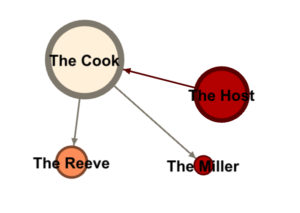
Text
The framing narratives were undoubtedly important to Chaucer, and they appear to have been a part of the Canterbury Tales that he toiled over even longer than the tales themselves. For example, the “Hengwrt manuscript,” widely thought to be the most “authoritative” copy of the Canterbury Tales, was likely compiled during Chaucer’s lifetime or soon after (unlike the Ellesmere manuscript, which, while it was copied by the same scribe, appears to have been produced in the decades following Chaucer’s death; Ellesmere contains the order of tales most often followed in modern editions).[4] The manuscript was produced in discrete booklets, sequences of quires that could be moved around if need be, and the compiler of the text was likely part of a circle of Chaucer’s readers who exchanged individual sections of tales as they were produced and edited (Hanna 146).[5] According to this scenario, it is possible that the actual tales represent the least stable elements in Hengwrt, as Chaucer constructed the framing narrative to provide links between tales, without ever deciding on a definite order (Hanna 147). If this is indeed the case, it offers a compelling view of Chaucer working and reworking his material specifically to create the entertaining yet “realistic” exchanges between pilgrims in the framing narrative. Far from just window-dressing for the tales, the framing narrative figuratively “shapes” the tales themselves, adding and extending meaning (Windeatt 216).[6] It would not be a stretch—given the material construction of the Hengwrt text described above—to suppose that these sections represent Chaucer’s most original writing in the Tales (the tales themselves, for the most part, are translated or adapted from other sources). The framing narratives undoubtedly provided a rich space in which Chaucer could more fully explore important themes, such as the temporal and narrative anxieties noted above. I will focus on those sections of the Canterbury Tales which, as highlighted by the network analysis I have performed, include the sharpest and most revealing interactions among pilgrims with respect to these anxieties, and how power is deployed in relation to them.
The first of these interactions occurs in what I have labeled “Fragment 1-a,” which includes the Miller’s Prologue – but the term “fragment” requires a brief discussion. As readers finish the General Prologue and begin the Canterbury Tales proper, an unexpected difficulty arises. As noted in the previous paragraph, the order of the Canterbury Tales was never definitively arranged by Chaucer, so far as we know. That order, as well as the division into ten “fragments,” is a product of modern editorial decisions, specifically those of the editors of The Riverside Chaucer. The more recent Broadview edition of the Canterbury Tales (2008) follows Riverside’s order, divisions, and labels. The editor of Riverside notes, “The work survives in ten fragments . . . editorial units determined by the existence of internal signs of linkage—bits of conversation or narrative that explicitly refer to a tale just told or to one that immediately follows. There are no explicit connections between the fragments” (5). As Robert J. Meyer-Lee compellingly argues, there is good reason to question not only the order of tales, but also the stability of these “editorial units” and their designation as “fragments.” As Meyer-Lee points out, no existing manuscript copies of the Canterbury Tales actually reflect these editorial units (49-50); he prefers the designation “blocks” to “fragments” (53). Other scholars have responded, with Arthur Bahr defending the label “fragment” for the way it “admirably conveys [a] sense of incompleteness not as loss but as interpretive invitation.”[7] Ruth Evans, meanwhile, discusses the problematic “modernist” implications of the word “fragment,” which (following T.S. Eliot) perhaps implies “a yearning for a lost unity and coherence, to say nothing of a yearning for a lost past.”[8] Further, Evans points out, while Chaucer tells readers in the Miller’s Prologue to “turne over the leef and chese another tale” if we wish (MillP 3177), the Canterbury Tales “are not akin to the phenomenon of the Choose Your Own Adventure books.” This is, after all, a pilgrimage; some kind of progress, and thus narrative progression, is indicated. But readers do well to keep in mind that we simply don’t know what the intended order is, nor the way in which the tales and frame narrative are intended to fit together. These textual uncertainties and contested editorial interventions are all the more reason to carefully scrutinize the framing narrative for clues about Chaucer’s development of characters and narrative themes in the Canterbury Tales. Keeping the above in mind, and despite the critical disagreements over nomenclature, my numbering follows the ten-fragment system in Riverside, with a connection implied between fragments nine and 10. To make a further distinction, I have used letters to indicate separate blocks of prologues and tales within the fragments (see figures in text and below).

And now back to that notable interaction. The Knight has just finished his tale (the first told on the pilgrimage); “al the route” proclaims it a “noble storie … namely the gentils everichon” (MillP 3110-13). Harry Bailly expresses his enthusiasm to the Knight (and perhaps more broadly to the company at large), and turns to the Monk to ask him to go next. At this point the Miller interrupts and insists on telling a tale. The Host attempts to dissuade him: “Som bettre man shal telle us first another” (MillP 3130); but after the Miller threatens to leave the pilgrimage altogether, the Host relents. Yet the episode is not finished. Hearing that the subject of his tale will be a carpenter who is cuckolded by a clerk, the Reeve (a carpenter by trade) violently interjects and urges the Miller to stop. The rest of the prologue is taken up with the Miller’s drunken defense of his subject matter, and the narrator (that is, Chaucer the character) excusing himself for some pilgrims’ rude speech: “Blameth nat me … / The Millere is a cherl; ye know wel this” (MillP .3181-82). Some obvious, and some not-so-obvious, patterns emerge at this early moment.
For one thing, it becomes clear that Harry Bailly’s presence will loom large in these framing sections as facilitator and mediator—indeed, he appears in every single one. Harry will keep things moving with a quick comment, suggest the next tale-teller, and step in when there is a dispute. Yet he is not necessarily determined, or well-equipped, to settle disputes; we immediately sense that his temper is easily provoked, as he first speaks to the Miller with an even tone, but when the latter refuses to be silent, he snaps, “Tel on, a devel wey!” (MillP .3134). This penchant for anger perhaps partially explains his seeming inability to manage the telling of tales effectively, despite the idea of the contest originating with him and despite his being the judge of it. The picture of Harry Bailly that gradually emerges over the course of the Canterbury Tales is that of a blustering fool, ironically undercut by some of the pilgrims (and by his own words), one who yet aspires to and wields a certain kind of power. Both temporal and narrative anxieties begin here in Fragment 1, growing and changing throughout the Canterbury Tales.
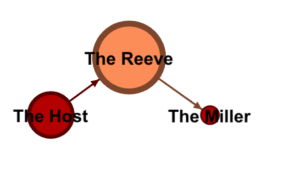
In the aftermath of the Miller’s Tale, the Reeve is the only one not amused. He begins to approach his own tale in a roundabout way, which prompts the Host to interrupt: “Sey forth thy tale, and tarie nat the tyme./ Lo Depeford, and it is half-wey pryme!” (RvP 3905-06). Noting this and other instances of Harry’s impatience, Barbara Page writes, “what, we may ask, is the rush?” While Harry might be a busy man, she adds, “Sheer impatience and fear of boredom drive him” (8). Here it must be noted that Harry is the only one on the road to Canterbury who is not a pilgrim; he has a business to get back to. Time is a constant preoccupation for him. He gives a long discourse on time in the Introduction to the Man of Law’s Tale, which begins,
“Lordynges,” quod he, “I warne yow al this route
The fourthe party of this day is gon.
Now for the love of God and of Seint John,
Leseth no tyme, as ferforth as ye may.
Lordynges, the tyme wasteth nyght and day
And steleth from us…” (MLI 16-21)
This poetic, almost Ecclesiastic speech is Harry’s most eloquent statement on the need to hurry, but it is far from his last. He cuts “Geoffrey Chaucer” off during his Tale of Sir Thopas, memorably saying, “Thy drasty rymyng is nat worth a toord! / Thou doost noght elles but despendest tyme” (Thop 930-31). As Page writes, “[Harry’s] critical obtuseness and impatience, of course, set him up as the butt of Chaucer’s elaborate literary joke since what follows is the endless ‘Tale of Melibee’” (8). Finally, when Harry turns to the Parson to wrap up the Canterbury Tales, he urges him to do so “in litel space” (X.73). Yet the Parson, though having promised a “myrie tale in prose / To knytte up al this feeste and make an ende,” launches instead into what amounts to a very long sermon (ParsP 46-47).
Over the course of the Canterbury Tales, then, the Host seems increasingly at odds with the pilgrims when it comes to the pace of tale-telling, and they seem increasingly bold in ironically undercutting these concerns. I would argue that his temporal anxiety is a reflection of who he is—a representative of the merchant class—and what he wants out of the story-telling. He is a man who works for a living, so to speak, and he wants tales that move along quickly. As rendered by Paul Strohm with exquisite detail in his 2014 biography of the poet, Chaucer would have had ample opportunity to study the merchant class of London during his tenure as controller of wool customs, concurrent with his residence at Aldgate (1374-1386) (see Strohm, Chaucer’s Tale, particularly chapter 3, “The Wool Men”). Perhaps this desire for brevity on the part of the Host also, in part, explains his narrative anxiety, which emerges in other framing narrative segments.
The narrative anxiety of the Host is, like his temporal anxiety, proscriptive, and takes a darker, almost tyrannical turn. At times the Host seems determined to silence or even banish pilgrims who rebel against his authority, picking on certain pilgrims or fomenting disagreements (see Bertolet 203-4). One such moment illustrative of the Host exerting his authority occurs when two characters, the Canon and Canon’s Yeoman, attempt to join the pilgrimage in progress. In brief: The Canon hails the pilgrims and asks if he can join them. The Canon’s Yeoman then addresses Harry directly, assuring him he can tell a tale “of murthe and eek of jolitee” (CYP 600). Yet Harry expresses doubts based on the Canon’s rough appearance, and the Yeoman gradually admits his own reservations; the Canon, overhearing this, orders the Yeoman to be silent. He refuses, the Canon leaves, and at Harry’s encouragement the Canon’s Yeoman stays to tell his own tale, one demeaning to the Canon.
Looking more closely at the parts of the framing narrative that involve the most conflict, however, the idea of Harry Bailly as a tyrant falls apart somewhat. In the lengthy Wife of Bath’s Prologue, the Wife is interrupted by the Pardoner, but only so that the latter can chide her for preaching, and then (perhaps ironically) the Pardoner encourages her to “Telle forth youre tale, spareth for no man, / And teche us yonge men of youre praktike” (WBP 186-87). At the conclusion of her prologue, the Friar and Summoner begin bickering—a preview of the mutual “quitting” that will follow—and Harry actually intervenes to make peace, allowing the Wife to go on with her tale (WBP 850). He repeats this peace-making effort in the Friar’s Prologue, saying, “We wol have no debaat. / Telleth youre tale and lat the Somonour be” (FrP 1286-89). Interestingly, as network analysis illustrates, the Friar never actually responds to Harry’s order; instead, the Summoner insists that the Friar proceed with the insulting tale he has promised, remarking, “By God, I shal hym quiten every grot” (FrP 1292). Not unlike the first such dispute, outlined above (when the Miller insists on following the Knight and refuses Harry’s orders to relent), Harry pokes his head into a situation, only to find the other participants talking over him, ignoring his wishes as to the order of speakers and the kind of tales they will tell.


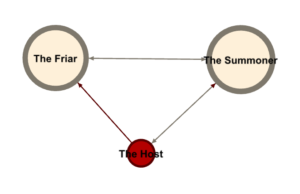
In a sense, these early encounters seem to change Harry’s mind about tale-telling, and thus alter or perhaps ease his narrative anxiety. While in the General Prologue he famously specifies that the winner of the contest would be whoever “that telleth in this caas / Tales of best sentence and moost solaas,” that is, tales with the best moral wisdom and most entertainment value, he increasingly skews towards the latter requirement as the pilgrimage goes on (GP 797-98). A few examples can suffice. At the end of the Physician’s Tale, Harry laments the grim matter of the story, and turns to the Pardoner, saying, “Telle us some myrthe or japes right anon” (PardI 319). The Pardoner agrees, but it is the “gentils” who object, saying “Nay, lat hym telle us of no ribaudye! / Telle us som moral thyng …” (PardI 324-25). The Pardoner instantly agrees to this demand, and thus Harry’s authority is circumvented once more. In the conclusion of the Pardoner’s Tale, Harry is moved to perhaps his greatest display of anger, as the Pardoner perhaps revisits the invitation to tell a “jape” or joke. Finishing his macabre tale of three wicked revelers getting their just desserts, he addresses the Host, inviting him, as the one “moost envoluped in synne” to “kisse my relikes everychon” (PardT 942, 944). Harry snaps at the Pardoner, reminding him that he’s already admitted he deals in fake relics, and adding:
I wolde I hadde thy coillons in myn hond
In stide of relikes or of seintuarie.
Lat kutte hem of, I wol thee helpe hem carie. (PardT 952-54)
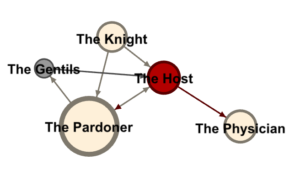
In essence, Harry threatens to cut off the Pardoner’s “coillons,” or testicles, and make him carry those as “fake” relics.[9] The Pardoner falls silent in anger, and Harry says, “I wol no lenger pleye / With thee, ne with noon oother angry man” (PardT 958-59), implying that he has had enough. Yet the Knight steps in, preserving the fellowship and seeming to make peace between the two by getting them to, essentially, “kiss and make up” (PardT 968). While Harry’s short temper is again on display, so too is the ability of other pilgrims to redirect it and smooth out its consequences.
Another example emerges from the Cook’s Prologue in Fragment 1, and especially its arguably connected sequel in the Manciple’s Prologue in Fragment 9. In the Cook’s Prologue, immediately following the Reeve’s Tale, the Cook threatens to “quite” the Host himself with a tale, then tells a lewd, seemingly incomplete story of a shopkeeper and his apprentice (some critics suggest that Chaucer meant to cancel this tale or move it elsewhere, while others believe Chaucer intended this to be a continuation of the earlier exchange between the Cook and Host; I hold with this latter view). In the Manciple’s Prologue, Harry turns to the obviously drunken Cook, chiding him for a tale:
Is that a cook of Londoun, with meschaunce?
Do hym come forth, he knoweth his penaunce;
For he shal telle a tale, by my fey,
Although it be nat worth a botel hey. (MancP 11-14)

By inviting a tale from the Cook, Harry seems to have come full circle, now embracing the drunken merriment that he had resisted when the Miller interrupted him in Fragment 1. The Cook is so drunk he can barely hold up his head, however, and eventually falls from his horse (MancP 48). The Manciple steps in with a tale—insulting the Cook and actually drawing a rebuke from Harry—then, as noted above, Harry ends by asking the Parson for a brief, merry note on which to end things, but is ironically undercut.
Although network visualizations cannot show the quality of Harry’s impatience with regards to time, nor that of his anxiety with regards to narrative, through them we do glimpse the importance of Harry throughout the Canterbury Tales in a clearer light. The underlying metrics of the network depicted in the framing narrative of the Canterbury Tales are similar to those of classic works of literature studied by Pádraig Mac Carron and Ralph Kenna, which in turn, they argue, resemble “real social networks.”[10]
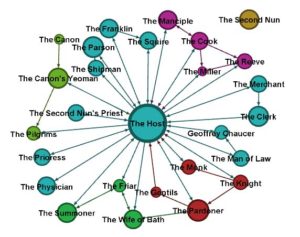
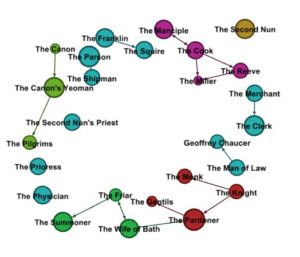
Yet if we remove Harry from the network, it falls apart almost completely—Harry has 42 network edges (which represent distinct interactions with Canterbury pilgrims), with none of the other pilgrims remotely close to this (the Cook has six; the Friar, Wife of Bath, Pardoner, and Miller have five, and so on). With Harry removed, suddenly all of these connections collapse.[11] Dramatically, the number of connected network “communities” nearly doubles, from seven with Harry to thirteen without. [12] Looking at the graphs of the network produced by the analysis with and without Harry bears out this dramatic difference, and exposes the network in the Canterbury Tales as highly artificial.
The Canterbury pilgrimage as described by Chaucer is, after all, a highly artificial social situation. This is what network analysis helps to remind us of, especially while viewing the graphs of individual fragments. The graphs most often show the Host facilitating the transition from one tale to the next, as in Fragment four and five. In busier graphs, Chaucer is seen to bring certain characters together for reasons that perhaps reflect the temporal and narrative anxieties examined in this chapter; Fragment six is a good example of this. Here, we observe that the “gentils” (of whom, presumably, the Knight is one), are in proximity to the Knight as an individual, with both engaged with the Pardoner (arguably the vilest of the pilgrims) and the Host. It is easy to forget that the gentils address the Pardoner even prior to his prologue, at the close of the Physician’s Tale (contravening the Host in asking for a “moral” tale) and that the Knight addresses the Host and Pardoner many lines later at the close of the latter’s tale, urging peace between them. In this way, the tension between Harry’s desire for mirth and japes and the gentils’ longing for morality and fellowship is more apparent. Likewise, Fragment nine and ten brings together the Manciple, the Cook, the Parson, the Host, and the whole company of pilgrims. The special concern with decorum in speech is brought to a close by reintroducing the Cook – who had challenged the Host at the end of Fragment one – this time in relation to the Manciple, a low-level expert in legal discourse, and the Parson, the holiest of the pilgrims. While it is impossible to fully examine temporal and narrative anxiety by looking at the framing narrative alone, as some of the tension produced by these anxieties plays out in the tales themselves, I hope this chapter (and the accompanying network visualizations) has helped illuminate the importance of the Host in shaping the action and fellowship of the Canterbury Tales.
Transformation
Questions and projects for the reader:
- What are some other ways to think about the relationships between pilgrims in the framing narrative of the Canterbury Tales, and the Host’s role in them?
- Do you believe that Harry Bailly, the Host, is naive and bumbling, as some critics say, or shrewd and despotic? In other words, to what extent does the Host “lose control” of the tale-telling enterprise—or does he in fact manage the tale-telling expertly?
- While the Host calls on various pilgrims to tell a tale, he does not tell one himself. What kind of tale do you suppose he would have told, if asked? For further discussion: There are some pilgrims named in the General Prologue, such as a “Haberdasshere” (or “hat-maker”), Carpenter, and Plowman, who do not actually tell a tale. What kind of tale would they tell, and how do you suppose they would interact with other pilgrims in the framing narrative?
- Download a version of the free Gephi software, read the tutorials, and create your own network analysis of the Canterbury Tales. For example, one could record “hostile” interactions between pilgrims and use those as edges between network nodes. One could also study relationships between pilgrims and characters within tales themselves.
Works Cited and Suggestions for Further Reading:
Bertolet, Craig. “The Anxiety of Exclusion: Speech, Power, and Chaucer’s Manciple.” Studies in the Age of Chaucer 33 (2011): 183-218.
Casey, Jim. “Unfinished Business: The Termination of the Cook’s Tale.” The Chaucer Review 41:2 (2006): 185-196.
Dinshaw, Carolyn. “Eunuch Hermeneutics,” ELH 55:1 (1988): 27-51.
Hanna, Ralph III. Pursuing History: Middle English Manuscripts and Their Texts. Stanford: Stanford University Press, 1996.
Mac Carron, Pádraig, and Ralph Kenna. “Universal properties of mythological networks.” epl 99 (2012): 1-6.
Meyer-Lee, Robert J. “Abandon the Fragments,” Studies in the Age of Chaucer 35 (2013): 47-83.
Mooney, Linne R. “Chaucer’s Scribe,” Speculum 81:1 (2006): 97-138.
Moretti, Franco. Graphs, Maps, Trees: Abstract Models for Literary History. New York: Verso Books, 2007.
Page, Barbara. “Concerning the Host.” The Chaucer Review 4:1 (1969): 1-13.
Pichaske, David R. and Laura Sweetland. “Chaucer on the Medieval Monarchy: Harry Bailly in the ‘Canterbury Tales.’” The Chaucer Review 11:3 (1977): 179-200.
Pugh, Tyson. “Queering Harry Bailly: Gendered Carnival, Social Ideologies, and Masculinity under Duress in the ‘Canterbury Tales.’” The Chaucer Review 41:1 (2006): 39-69.
Rudd, Gillian. “‘rather be used / than be eaten’? Harry Bailly’s Animals and The Nun’s Priest’s Tale.” Studies in the Age of Chaucer 34 (2012): 325-30.
Scheps, Walter. “‘Up Roos Oure Hoost, and Was Oure Aller Cok’: Harry Bailly’s Tale-Telling Competition.” The Chaucer Review 10:2 (1975): 113-28.
Strohm, Paul. Chaucer’s Tale: 1386 and the Road Canterbury. New York: Penguin Books, 2014.
Warner, Lawrence. “Scribes, Misattributed: Hoccleve and Pinkhurst,” Studies in the Age of Chaucer 37 (2015): 55-100.
Williams, Tara. “The Host, His Wife, and Their Communities in The Canterbury Tales.” The Chaucer Review 42:4 (2008): 383-408.
Windeatt, Barry. “Literary Structures in Chaucer.” The Cambridge Companion to Chaucer. Edited by Piero Boitani and Jill Mann. New York: Cambridge University Press, 1986.
Additional Figures:
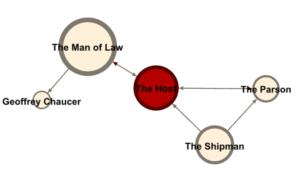
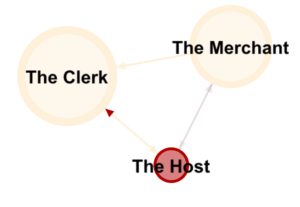
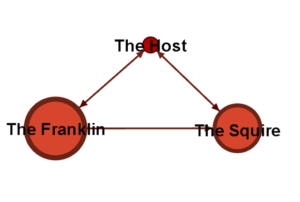
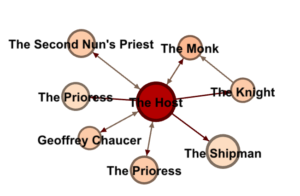
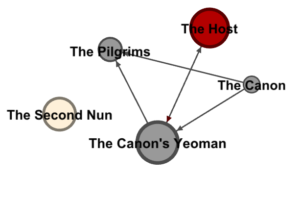
Notes:
[1] I am grateful to Myra Seaman and Alex Mueller for critical feedback on this essay.
[2] See Bertolet, “The Anxiety of Exclusion,” 184. While Bertolet focuses on the Manciple’s Tale, his larger point is about the threat of exclusion from the company that each pilgrim faces for overstepping the boundaries of acceptable speech.
[3] References: See Johanna Drucker, Graphesis: Visual Forms of Knowledge Production (Harvard University Press, 2014); Franco Moretti, “Network Theory, Plot Analysis” (Pamphlet 2, Stanford Literary Lab, 2011); see also Matthew Jockers, “The Way We Read Now,” (Stanford Magazine, 2008); and Katie Walden, “Franco Moretti, Network Theory, and Plot Analysis” (Storify, 2015) for a compilation of responses to Moretti.
(Moretti:) http://litlab.stanford.edu/pamphlets/
(Jockers:) http://alumni.stanford.edu/get/page/magazine/article/?article_id=31196
and http://www.matthewjockers.net/
(Walden:) https://storify.com/kwalden0323/franco-moretti-network-theory-and-plot-analysis
[4] See the National Library of Wales (https://www.llgc.org.uk/?id=257), where Hengwrt is housed. The scribe has been identified as Adam Pinkhurst (see Mooney, “Chaucer’s Scribe”; see also Strohm, Chaucer’s Tale). However, while Pinkhurst certainly copied some of Chaucer’s poems, his identity as the scribe of Hengwrt and Ellesmere has been called into question (see Warner, “Scribes, Misattributed.”)
[5] See Hanna, Pursuing History.
[6] See Barry Windeatt, “Literary Structures in Chaucer,” 216.
[7] Arthur Bahr, “Celebrate Fragments,” New Chaucer Society Blog (2013).
http://newchaucersociety.org/blog/entry/celebrate-fragments
[8] Ruth Evans, “Literary Criticism with Book History: A Response to Arthur Bahr’s ‘Celebrate Fragments’,” New Chaucer Society Blog (2013).
http://newchaucersociety.org/blog/entry/literary-criticism-with-book-history
[9] See Carolyn Dinshaw, “Eunuch Hermeneutics,” for a fascinating and seminal discussion of this moment and its implications.
[10] See Pádraig Mac Carron and Ralph Kenna. “Universal properties,” 3. For example, in the framing narrative of The Canterbury Tales, the average degree (distance between network nodes) is 2.103 (similar to that in the Old English Beowulf, the Irish Táin Bó Cúailnge, and Homer’s Iliad); the average path length is 2.107 (compared with Beowulf at 2.37, the Táin at 2.76); the average clustering coefficient is .559 (compared with Beowulf at .69, the Táin at .82, the Iliad at .57).
[11] With Harry gone, the average degree jumps to .714, path length goes to 1.484, and clustering coefficient falls all the way down to .042.
[12] The parameter for determining a network connection was direct address: who speaks to whom in a given passage. Thus, all edges are directed. The colors above show modality: clusters of connected pilgrims. In the figures below, the colors are less important, but I have adjusted the node size to reflect who does the most speaking.

This work is licensed under a Creative Commons Attribution-NonCommercial-NoDerivatives 4.0 International License.